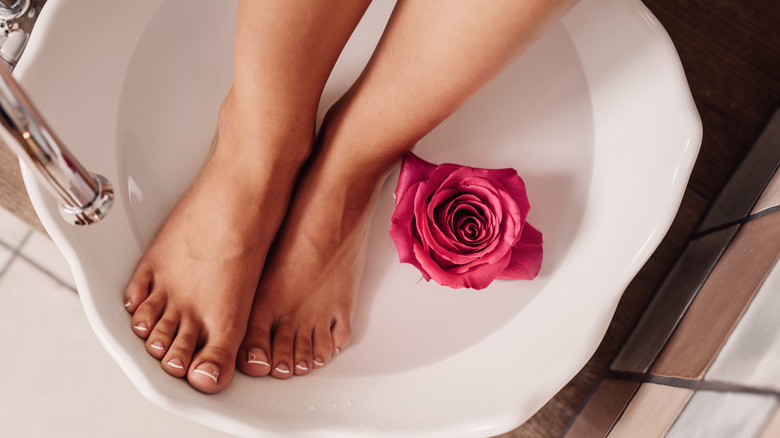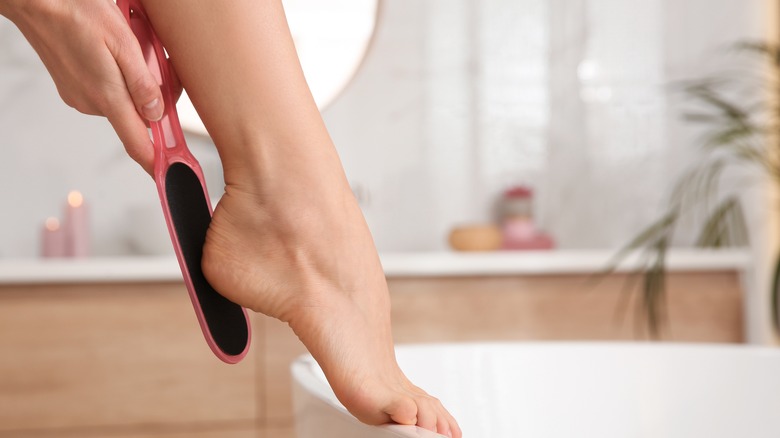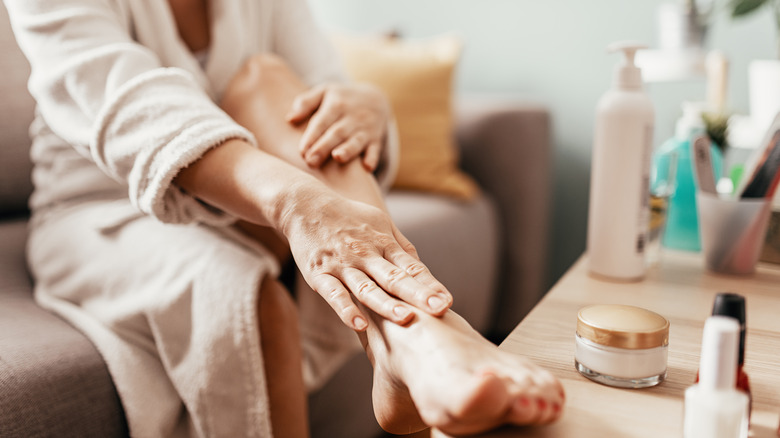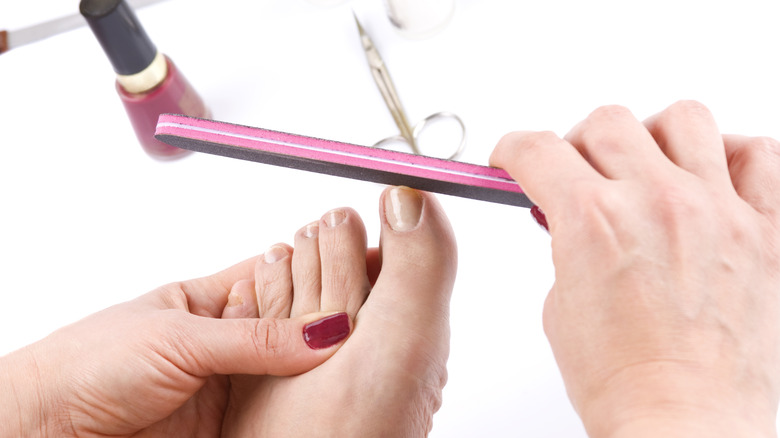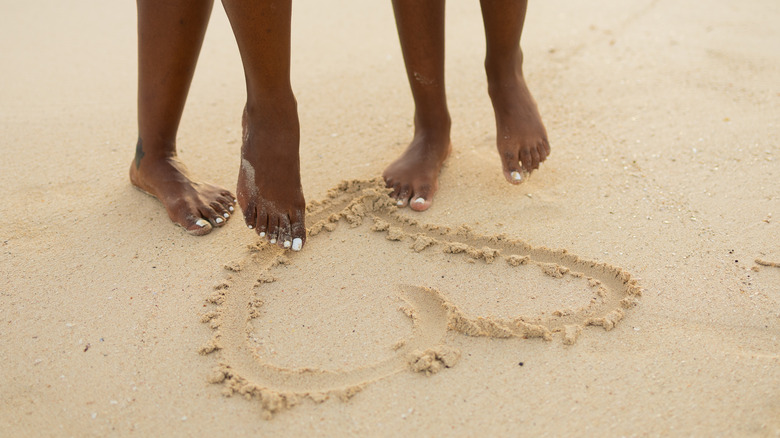Your Feet Deserve A Skincare Routine Too - Here's How To Create One
When you wind down for the night or go through your morning routine, your skincare regimen is likely focused on your face, with lotion application to your hands, arms, and perhaps your legs. One area of our bodies that provides a lot of the footwork — pun intended — for our daily movement, but which often goes overlooked when it comes to skincare, is our feet. It's about time we give our feet a standing ovation, or rather resting ovation, and prioritize skincare of these invaluable extremities which get us through our days from start to finish.
No matter what your foot-based skincare routine looks like, you should always start by washing your feet in warm water along with soap. You may choose to do so during your regular daily shower, while taking a bath, or through a specialized foot soak miniature bath with epsom salts or essential oils. My Health Alberta advises paying close attention as you wash each foot to take note of any new developments on the skin, including calluses, warts, growths, or discoloration. It's also critical to be mindful while you wash your feet because you want to be certain to clean off all of the dirt, bacteria, and pathogens since your feet most likely have more contact with the ground than any other part of your body. As you spend time getting to know the details of your feet, you will likely develop a deeper appreciation for them. Here's how to practice quality foot skincare.
Exfoliation eliminates calluses
Especially as you first begin your foray into foot skincare, you are quite likely to stumble upon some calluses, hardened skin, dry skin, and potentially cracked or peeling skin, particularly around your heels. This is where the key step of exfoliation comes in, which is the relaxing phase of a pedicure where a foot scrub is generally used to massage your feet and calves. According to Skincare.com by L'Oreal, there are a few different ways you can exfoliate your feet at home, including giving yourself an exfoliation-based foot massage that might not stack up to the one at your nail salon but will still be quite soothing nonetheless. Don't be afraid to try new methods or give multiple forms of exfoliation a go before settling on the tool or method that feels best for you and your feet. While you're in the shower or taking a bath, you may enjoy a scented foot scrub to eliminate dead skin from your feet, going from your ankles down to the soles of each foot with a mini-massage.
If you find thicker calluses or excessive dead skin on your feet, then a pumice stone, exfoliating brush, or battery-operated exfoliating scrubbing device is likely the place you'll want to begin your foot exfoliation endeavor. You can also double up by using foot scrub applied to a pumice stone or exfoliating brush, though be certain to wet the skin of your feet and the tool in advance to avoid irritation.
Moisturization maintains hydration, but there's a caveat
After washing your feet and rinsing debris from exfoliation, it's time to curate the part of your foot-based skincare routine that will provide you with buttery soft skin from your soles to your toes. This step is all about moisturizing the skin on your feet. There are specially designed foot creams with ingredients tailored to tough skin on feet, though moisturizing the skin on your feet can be achieved using the same lotion you apply to your hands and body. But, as WebMD advises, you should avoid applying hydrating lotion in between your toes. Admittedly, this doubtlessly seems bizarre since the skin between toes tends to be naturally soft and sensitive, and it would seemingly make sense to apply lotion to all areas of skin on your feet. However, that increased moisture which is allowed to fester between toes can lead to skin infections, fungal growths, and unwanted visitors like warts.
If lotion does get between your toes, use a towel to wipe it off. You can also use baby powder, foot skincare's secret solution to dampness, for absorbing excessive moisture from skin, particularly upon getting out of the shower or if your feet are sweaty from warm outdoor temperatures or daily movement.
Comprehensive cuticle care changes the game
Set up shop for an at-home DIY pedicure when you get to the step in your foot-based skincare routine for tending to your toenails. According to Bennett Podiatry, rubbing the soles of your clean feet won't solely — once again, pun intended — give you a relaxing and soothing self-massage, but it will actually improve the circulation in the extremities and encourage more active blood flow to and from your feet. While you treat yourself to DIY pedicures, choose snacks high in vitamin D and calcium, which are the two essential nutrients which promote foot health.
When focused on the wellbeing of your toes, use a cuticle cream or oil to keep the cuticles of nails moisturized, though again be mindful of not allowing any lotion or oil to settle in between toes, thus risking infection or fungal growth, says Women's Health. Petroleum jelly, aka Vaseline, is also effective on the cuticles and skin surrounding toenails, both of which are prone to experience calluses. It's important to stay on top of toenail maintenance by regularly filing nails down to a point where they're not so short that they risk becoming ingrown or infected, but not too long that they impede your posture or stance when wearing shoes throughout the day, particularly if you're constantly on your feet. Think of this step as the Goldilocks rule of foot skincare. Cut and file toenails straight across to avoid ingrown, infected, or injured nails or surrounding skin, says Healthline.
Sun protection is proactive skincare
It's no secret that sunscreen is highly encouraged for daily use given the well-known damaging effects of ultraviolet (UV) rays from sunlight exposure, which in turn can increase risk of developing skin cancer if sunscreen isn't applied to exposed skin when spending time outside. When it comes to foot-based skincare, protecting the skin on your feet is as important as exfoliating and moisturizing. Pertaining to the tiniest spots of skin around your toenails and along the sides of your feet, the same golden rule stating skincare is self care when having fun in the sun applies.
Martin Foot and Ankle encourages prioritizing head-to-toe coverage with sunscreen, emphasizing the need for use of SPF 30+ products on all areas of feet if you plan to wear sandals or spend time lounging poolside, along with reapplication of sunscreen to feet every two hours while outdoors. A surprising beach fact is that if you're spending time by the ocean waves, digging your feet in the sand or covering them with handfuls of sand can provide sun protection to the sensitive skin between your toes, beneath your nails, and on both the tops and bottoms of your feet. Of course, crafting a miniature sand castle on top of your feet isn't the same as wearing sunscreen, but if it's the only resource you have available then it will provide enough protection for a short time period. Similarly, using towels or items draped over feet can protect from sun exposure.
Footwear impacts skincare
The shoes you wear on your feet are as relevant to foot-based skincare as any other practice in your skincare regimen, effectively making footwear a form of skincare. WebMD states wearing tight or improperly fitted shoes can lead to calluses, blisters, and corns on the bottom of feet, which at the very least will make your feet hurt. In the case of blisters, raw skin could become exposed if the pustule pops or the skin peels. Never try to exfoliate or apply skincare products to exposed skin or raw sores so you don't exacerbate your pain and make the condition worse, thus extending your skin's wound healing.
In the spirit of shoes, you can care for your feet and practice healthy skincare are by selecting footwear with adequate arch support for your posture and longevity of your joint health. On that same note, you may want to avoid flimsy flip-flops and sandals if possible for their general lack of arch support and exposure of skin to UV rays. Regardless of the weather, temperature, or season of the outdoor climate, the skin on your feet will be best protected when wearing shoes that provide full coverage, recommends Martin Foot and Ankle. If you wear sandals, heels, or shoes with low ankle exposure, ensure that you're applying sunscreen to exposed skin prior to leaving the house and perhaps taking a travel size sunscreen tube with you for reapplication throughout the day.
Choose comfortable shoes so you can continue enjoying your newfound foot skincare routine!
